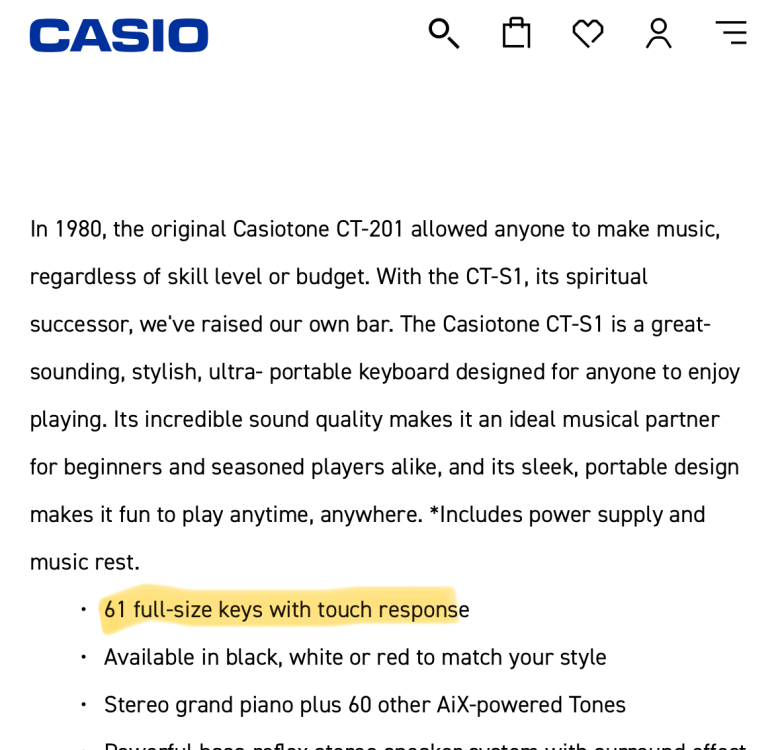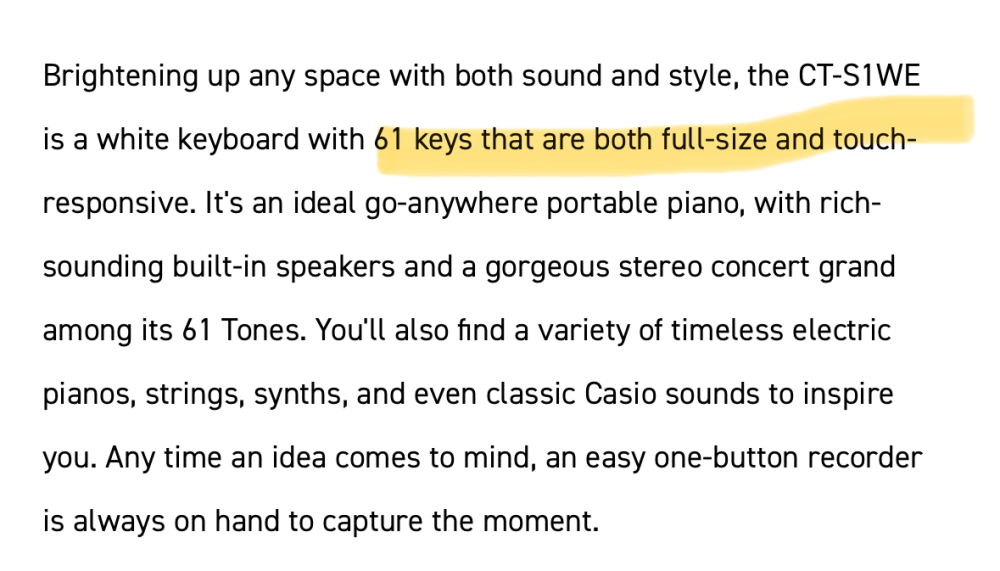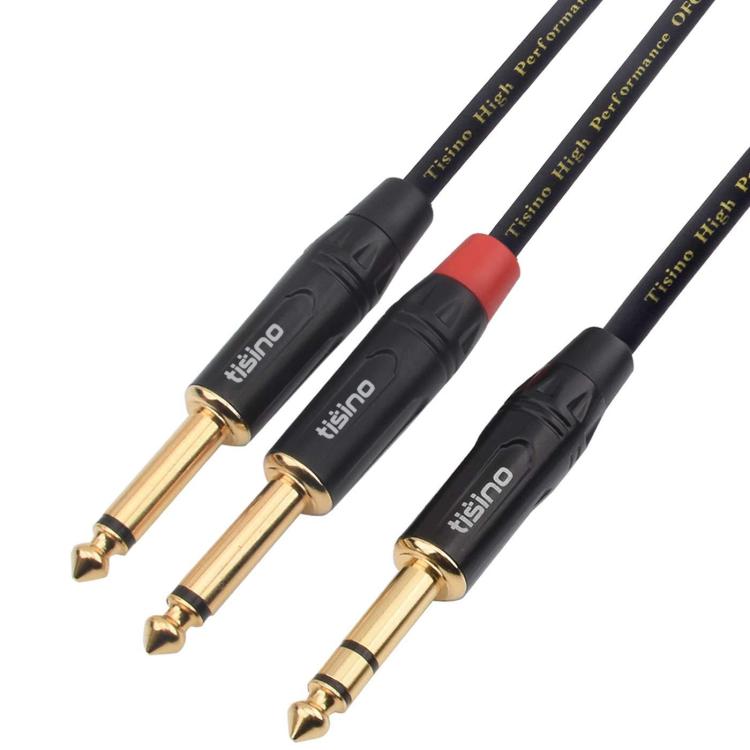-
Posts
1,157 -
Joined
-
Last visited
Content Type
Profiles
Forums
Downloads
Everything posted by Joe Muscara
-

Px-7000 won’t turn on
Joe Muscara replied to Mankan's topic in Privia PX-S7000 / PX-S6000 / PX-S5000
Have you tried using battery power? That should answer whether it's the power adapter or the instrument itself.- 1 reply
-
- 2
-

-
Have you turned it off since then?
-
Have you actually played a real acoustic piano? I have. I own one. I don't go between it and my CT-S1 (nor any of my other Casio keyboards) and notice any difference in the size of the keys. IMNSHO, you are wasting your time with this. Either the CT-S1 works for you or it does not. I have not heard a single other person complain about the key size of the CT-S series, and in fact, most people are blown away about the combination of portability and sound quality. I have a friend who busked across the U.S. with her CT-S1 and loves it. She also has an acoustic grand piano at home.
-
I don’t know where you’re getting this information from, but the keys on the CT-S1 and the rest of the CT-S models are full size. See the attached images from Casio’s CT-S1 product page.
-

After-note ringing/dissonance on GP-310
Joe Muscara replied to JamesO's topic in Celviano Grand Hybrid Series
That's an interesting problem/solution, and points out why we have these forums. I never considered the fact that one of the pedals might be kicking in (pun intended) and thus making the instrument sound slightly off. Thanks for sharing what happened, now we have another potential solution to suggest if something like this comes up again. Granted, we can't ask people with certain models to unplug the pedal unit, but there are many others where that's possible. Or, we can suggest they try and see what happens when they press the various pedals. For instance, if one of your pedals was acting in reverse, it might have sounded fine with the pedal pressed. Then we can tell them that needs to be fixed. -
Sweetwater covers you for two years after purchase. You should give them a call. They’ll see if they can get you going with support, and if not, take care of it for you.
-
First you have to tell us what tone you want to hear.
- 2 replies
-
- 1
-

-
- tones missing
- cdp-s350
-
(and 2 more)
Tagged with:
-
It’s not like the action on a real acoustic piano is absolutely silent, but you just can’t really try it without hitting the strings or something in their place. Play your PX-S7000 and enjoy it.
-

Casio Dimension Tripper Expression Controller.
Joe Muscara replied to XW-Addict's topic in General Casio Discussion
I saw the video of it that Sweetwater posted and they said it was a prototype, so it's likely to change. This guy had a lot of critiques of it if that's the case. I doubt this is the final shipping version. -
Because you're new. We had to set limits because of spammers. Some mornings we would wake up to dozens of junk posts by one account. Fortunately the forum software makes it easy to mark an account as a spammer and all the posts would go away, but in the meantime the place would be a mess. It would be nice if we didn't have to make real users jump through hoops to post here, but the spammers ruined it for everybody.
-

After-note ringing/dissonance on GP-310
Joe Muscara replied to JamesO's topic in Celviano Grand Hybrid Series
I hardly hear it on the unmodified part, and even then I have to listen for it. I think part of what's happening now is that phenomenon of, "once you hear it, you can't unhear it." In my personal experience, I can unhear or forget about things with the right kind of effort. You can't not hear it by saying to yourself, "don't think about that sound" just as much as if you said, "don't think about the Empire State Building" if you didn't want to think about it! Maybe that's what you could do. Every time you start to think about that sound, tell yourself, "don't think about the Empire State Building." That kind of thing works for me! -

Casio repair centers-only for certain models
Joe Muscara replied to Jokeyman123's topic in General Casio Discussion
They bought Moog fairly recently and just last week apparently laid off a number of employees at Moog's Asheville NC headquarters. It's not looking too good. -
Headphone ports would be audio only. I'm not sure there's an audio in on a Mac mini, it might depend on the model. But it wouldn't "recognize" it as much as see signal in something like a DAW like GarageBand or Logic or audio app like Amadeus Pro. USB out from the CT-S300 should connect to USB on the mini and give you MIDI data (use the CT-S as a controller with the sounds coming from the mini). GarageBand and Logic will show you if they're seeing MIDI data, and MINI Monitor is a useful free app to see the data being received as well.
-

Low volume in S300 when connected to headphone
Joe Muscara replied to S_JA's topic in General CT-S and LK-S Discussion
Regular headphones usually have a TRS plug, which stands for Tip Ring Sleeve. If they also have a mic, then they are often TRRS, with one of the rings being for the mic. Unfortunately, sometimes headphone jacks that are expecting TRS won't work well with TRRS plugs, which have become more common with the proliferation of mobile phones. You can look up more information about these online using the above as search terms. -
There are many many options for sound libraries available out there. My best advice would be to search and look for both written and video reviews. The written reviews would have depth, while the videos should give you examples of sounds. Also, videos from the manufacturers of the sounds should have audio examples as well. https://www.uvi.net might have something https://www.soundonsound.com/reviews/pop-brass-sample-libraries-buyers-guide This article is old (in internet/tech years) but I know a number of those companies are still around https://www.westwoodinstruments.com/instruments/solobrassuntamed/ something I stumbled across in a search https://www.syntheway.com/Aeternus_Brass.htm another one I found
-

Connecting ct-x800 to Audio Interface
Joe Muscara replied to weedreference's topic in CT-X700 / CT-X800
You would use a Y or splitter cable that has a stereo TRS jack on one end and two mono TS jacks on the other, all three jacks should be 1/4" male type, I believe. This is an example, no endorsement of brand nor vendor intended. You could also use one that has female plugs on the two TS ends, and then use regular TS male-to-male cables if that's all you can find. And if I'm wrong and the output jack on the CT-X800 is a stereo mini plug (3.5 mm), then the stereo plug should of course be that instead of 1/4".- 1 reply
-
- 1
-

-
The CDP-230R like many Casio keyboards supports "MIDI-over-USB" which means you can use a USB cable between the keyboard and the computer or iPad to play what are called "virtual instruments" on the computer or iPad (it can do things in the other direction as well but that's a topic for another time). You can find a number of virtual instruments online or in app stores for the device, including pianos, organs, synths, drums, guitars, etc. and wind instruments you mention. Purchase and download the ones you want (many offer limited trials, such as not all notes work or they "take a break" every so often), and by connecting the USB cable, you should be able to play the instrument on the device via the keyboard. The next trick is getting the output to your amplification system. If your device has a headphone jack, you can use that, but since most recent ones do not, you'll need an interface to connect audio cables as well as still allow you to connect the USB cable from the keyboard. The choices of interfaces are many, and depend on whether you're using an iPad or computer. That should get you started. We can discuss this more and others might have some input, unless you find the topic not interesting and don't want to put any further effort into this method. OTOH, some of us live for this musical & tech geekery.
-
Or,. use it as a controller to play samples on a computer or iPad. There are a ton of choices out there.
-

QUESTIONS about forums searches and WK-6600 rhythms
Joe Muscara replied to Aviatorboy's topic in WK-6500/6600 - CTK-6000/6200
I must admit, 90% or more of my visits to this site are on my computer, so I often forget that the design "hides" a bit when on a smart phone. I'm not even sure what's shown on an iPad. So if my instructions neglect those platforms (ones that I use all the time for other things), my apologies.🤷♂️ -

QUESTIONS about forums searches and WK-6600 rhythms
Joe Muscara replied to Aviatorboy's topic in WK-6500/6600 - CTK-6000/6200
Do you not see the search field near the top of the page? Once you do a search, it gives you tips on how you might improve your search results. Go to the topic area for the model you're asking about and post there. -

Potential water and debris damage
Joe Muscara replied to Schroeder's topic in General Casio Discussion
A lot of people don't realize that printed circuit boards are often rinsed at the factory. I'm sure the water is purified, though. I used to work at a place and after the boards went through the wave solder machine they would get rinsed. There are some components that can take it, and some can't. And, the dirty water that hit your keyboards allows the stuff in the water to get in lots of places that are bad. So I realize it's a little different, but my point is, like Brad said, you may be able to rinse your keyboards. If you can get some pure, deionized water to do it (I used to use water like that to make my own contact lens solution years ago), I think that would be the best. I'd make sure that all the contact strips and contacts were cleaned as well. And as Brad said, allow plenty of time to dry before powering it up again. Perhaps if you could isolate the rinsing to the parts that were impacted but avoid any parts that weren't, that might be a good thing to try. Unless the thing was submerged. -

Casio cdp 120 - 3 keys have become dead.
Joe Muscara replied to Treslupos's topic in Casio CDP Series
Are the keys together or separate? I would try the air as Brad suggests as well as working each key. If it is the rubber contacts, I think they're designed to be self cleaning but sometimes you have to work it.




